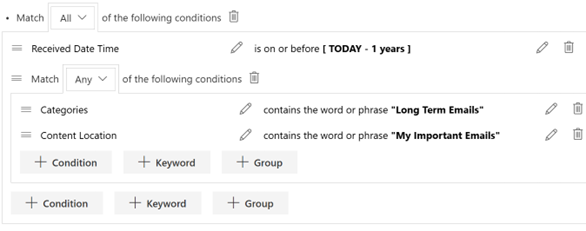 I just finished reading Bruce Miller's recent book, Managing Records in Microsoft SharePoint. If you have any doubts about using SharePoint as a repository to manage your records, or you think that that SharePoint out of the box with some customization, can meet your needs, you really should read Bruce Miller's book. You can clearly see that SharePoint, with the right 3rd party add-in, like Collabware CLM, can provide the enterprise level records management functions and experience that companies expect and that traditional records management solutions have provided in the past.
I just finished reading Bruce Miller's recent book, Managing Records in Microsoft SharePoint. If you have any doubts about using SharePoint as a repository to manage your records, or you think that that SharePoint out of the box with some customization, can meet your needs, you really should read Bruce Miller's book. You can clearly see that SharePoint, with the right 3rd party add-in, like Collabware CLM, can provide the enterprise level records management functions and experience that companies expect and that traditional records management solutions have provided in the past.
Mr. Miller clearly outlines out-of-the box SharePoint records management capabilities and limitations and discusses the need for a 3rd party add-in in order to ensure that retention rules have been applied correctly, documents and/or records are destroyed with proper oversite or intervention, and meet what is referred to as the F1000 level of ordinary record keeping.
Bruce does an excellent job describing a subset of the DoD 5015.2-STD records management capabilities he refers to as the Fortune 1000 (F1000) requirements. The F1000 capabilities will satisfy most organizations (outside the US Department of Defense (DoD) and some U.S. government nonmilitary organizations) and Collabware fully supports these.
Collabware CLM fits into SharePoint in what the book calls Add-in software, under the 'Displacement' architecture model. Collabware CLM essentially sits inside SharePoint and replaces SharePoint's native records management capabilities with a more robust set of features. In fact, Collabware CLM blends into the environment so well that SharePoint users do not even know that they are using non-SharePoint capabilities.
Table 10: Custodial Architecture on page 69 outlines some key considerations when choosing a 'Displacement' architecture versus other architectures and provides advantages and disadvantages of each. The table notes two disadvantages of the displacement model in the areas of scalability and provisioning capability. However, Collabware CLM negates these disadvantages. Collabware CLM is very scalable, able to be deployed to multiple SharePoint farms and sites by simply enabling the Collabware site features and identifying managed content types. In addition, our record center architecture is only limited by the amount of storage the customer can make available and will automatically provision additional repositories as required. Collabware CLM 2016 now provides the ability to automatically provision case team/project sites from SharePoint site templates, all without IT involvement. As a result, the choice of the displacement architected add-in, like Collabware, is very compelling.
I found the section on Rules Based Recordkeeping (RBR) particularly interesting. While Mr. Miller users a generalized model and terminology to discuss RBR, I found myself nodding in agreement as I read through the paragraphs. Collabware CLM was the first SharePoint add-in to provide content rules based processes and we continue to evolve these capabilities so that end users can have a simple, seamless and transparent record keeping experience. We want record keeping to occur in the background while end users simply carry out their normal business processes.
If you currently have SharePoint and intend to implement an add-in for records management sometime in the future, the section Pre-Add-in SharePoint Configuration is a must read. You might think that using some of the SharePoint out-of-the box records management features as an interim measure might help things along. However, the truth is that it can leave you with a costly legacy of additional SharePoint structure and configuration. In this case the book states 'Staying completely away from the native recordkeeping features is recommended'. Instead, Mr. Miller outlines a strategy to help prepare for your future add-in that will allow smoother transition and more constant long term management of your documents and records.
Finally, the section Selecting an Add-In, covers all the basics. I think the key point is to look at what is important to you and your organization and ensure those are highlighted in your selection process.
The only other comment I might add is about the selection process itself. Many organizations have procurement processes that require a formal Request for proposals (RFP) and response process. This process structure often limits communication between the parties and can lead to misunderstandings, apples to oranges comparisons etc. In my experience, roughly 50% of RFP processes end with a no decision. Think of how much time your organization has to put into developing the RFP and evaluating the responses. While the RFP process is often necessary, I encourage you to include a live demo of the add-ins you are considering early in your process, prior to entering your formal procurement process. Having an open conversation prior to the procurement process will allow you to have feature and function discussions in your context, identify possible show stoppers early on and also to see other product capabilities in action that may be very valuable to you but may not otherwise surface in a formal RFP/Response.
Overall, I liked the organization of the book and at 150 pages (before the appendixes), it does not take much of your time to read. I mostly found myself nodding my head in agreement and found that Collabware CLM aligns very well with what the book had to say.
If records management on SharePoint is in your future, I highly recommend including this book on your list of must reads!
Bruce Miller is the founder of RIM tech Consulting and author or the book Managing Records in Microsoft SharePoint, available on his website.
We hope you found this article insightful! Want to read more about optimizing your records management practice? Check out other related articles on our blog!
You can also download our free brochure to learn more about Collabware CLM that integrates with SharePoint for complete end-to-end compliance Automation. You can also read more about managing SharePoint in the cloud with Microsoft 365 + Collabspace.
![]()





